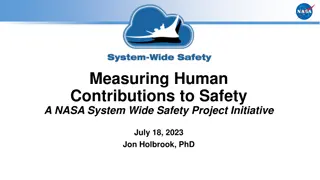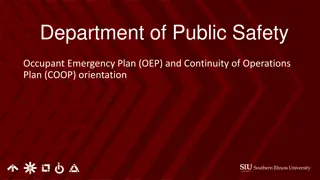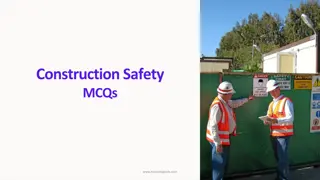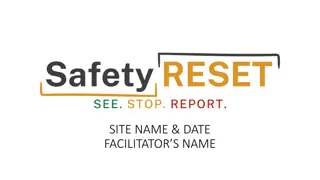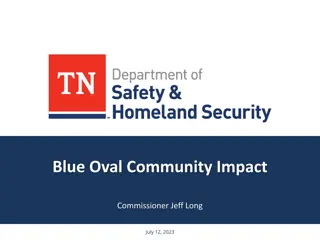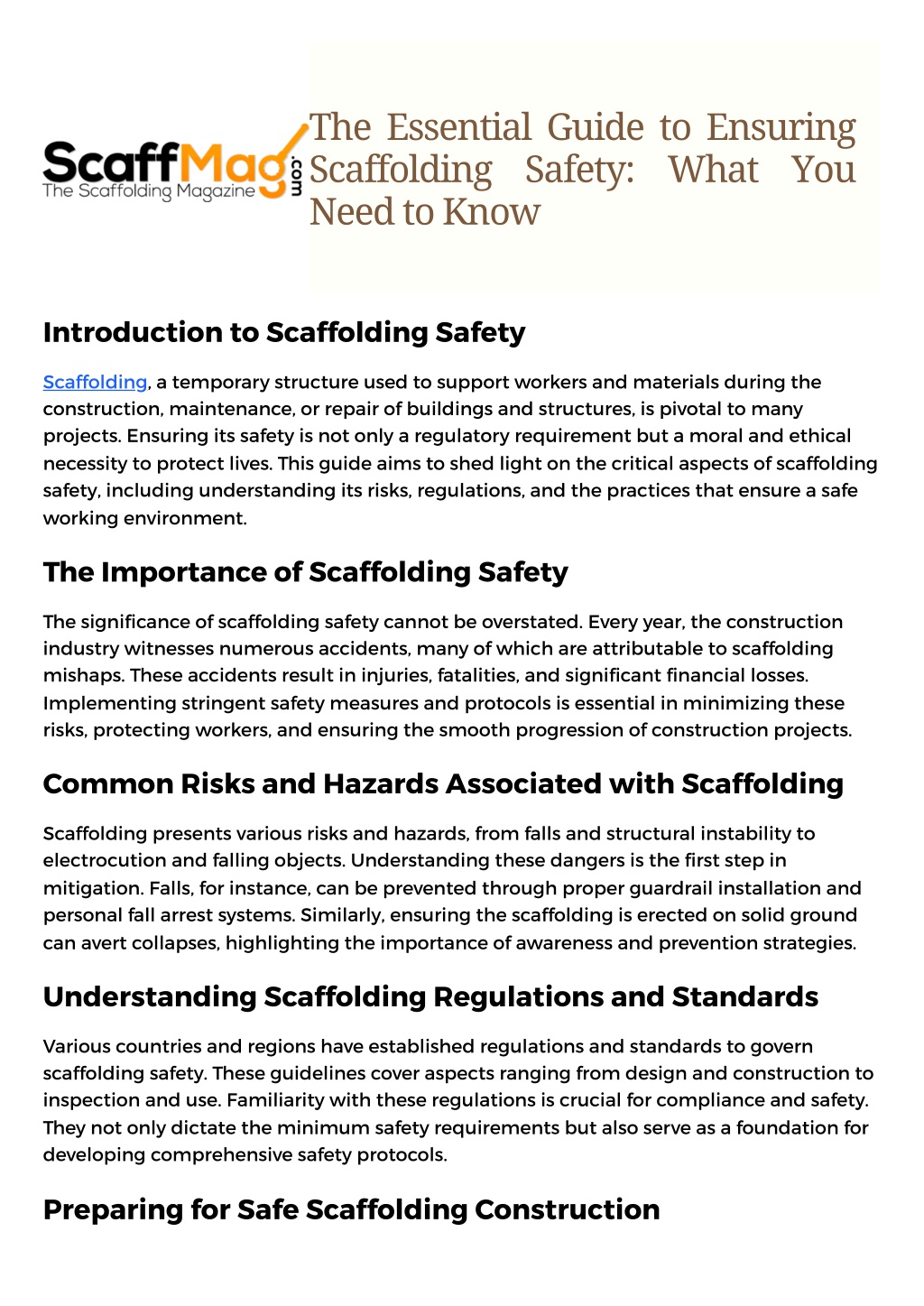
The Essential Guide to Ensuring Scaffolding Safety: What You Need to Know
This document is a guide to scaffolding safety. It covers the importance of safety, common hazards, regulations, and best practices for construction workers. It emphasizes the need for training, inspections, and proper equipment to prevent accidents and injuries.
Download Presentation
Please find below an Image/Link to download the presentation.
The content on the website is provided AS IS for your information and personal use only. It may not be sold, licensed, or shared on other websites without obtaining consent from the author. Download presentation by click this link. If you encounter any issues during the download, it is possible that the publisher has removed the file from their server.
Presentation Transcript
The Essential Guide to Ensuring Scaffolding Safety: What You Need to Know Introduction to Scaffolding Safety Scaffolding, a temporary structure used to support workers and materials during the construction, maintenance, or repair of buildings and structures, is pivotal to many projects. Ensuring its safety is not only a regulatory requirement but a moral and ethical necessity to protect lives. This guide aims to shed light on the critical aspects of scaffolding safety, including understanding its risks, regulations, and the practices that ensure a safe working environment. The Importance of Scaffolding Safety The significance of scaffolding safety cannot be overstated. Every year, the construction industry witnesses numerous accidents, many of which are attributable to scaffolding mishaps. These accidents result in injuries, fatalities, and significant financial losses. Implementing stringent safety measures and protocols is essential in minimizing these risks, protecting workers, and ensuring the smooth progression of construction projects. Common Risks and Hazards Associated with Scaffolding Scaffolding presents various risks and hazards, from falls and structural instability to electrocution and falling objects. Understanding these dangers is the first step in mitigation. Falls, for instance, can be prevented through proper guardrail installation and personal fall arrest systems. Similarly, ensuring the scaffolding is erected on solid ground can avert collapses, highlighting the importance of awareness and prevention strategies. Understanding Scaffolding Regulations and Standards Various countries and regions have established regulations and standards to govern scaffolding safety. These guidelines cover aspects ranging from design and construction to inspection and use. Familiarity with these regulations is crucial for compliance and safety. They not only dictate the minimum safety requirements but also serve as a foundation for developing comprehensive safety protocols. Preparing for Safe Scaffolding Construction
Preparation is key to safe scaffolding construction. This involves planning for the structure's layout, selecting the appropriate materials, and considering the environmental conditions. Moreover, assessing the load capacity ensures that the scaffolding can support the weight of workers, equipment, and materials, preventing overloading and potential collapses. Erecting and Dismantling Scaffolding Safely The processes of erecting and dismantling scaffolding are fraught with hazards. Skilled personnel should carry out these tasks, following established procedures to prevent accidents. The use of appropriate tools and protective gear is also vital in safeguarding workers against injuries during these phases. Ensuring Proper Maintenance and Inspection of Scaffolding Regular maintenance and inspection are cornerstone practices in scaffolding safety. Inspections should be conducted before use, after any alteration, and periodically during use, to identify and rectify potential hazards. Maintenance, on the other hand, involves repairing or replacing defective components, ensuring the scaffolding remains in safe working condition. Training and Certification for Scaffolding Safety Training and certification play a significant role in scaffolding safety. Workers should undergo comprehensive training to understand the risks associated with scaffolding and the measures necessary to mitigate these risks. Certification programs also ensure that workers have attained a standard level of competency in scaffolding safety practices. Best Practices for Working on Scaffolding Adhering to best practices is essential for safety when working on scaffolding. These include using personal protective equipment, keeping the work area tidy to prevent trips and falls, and adhering to load limits. Communication and coordination among workers also enhance safety, ensuring that everyone is aware of operations on the scaffolding. Scaffolding Safety Equipment and Gear The right safety equipment and gear are indispensable in preventing injuries. Hard hats, non-slip work boots, and harnesses equipped with lanyards for fall arrest systems are examples of essential gear for workers on scaffolding. These items provide a critical line of defense against common scaffolding-related injuries. Case Studies and Examples of Scaffolding Accidents
Examining case studies and examples of scaffolding accidents offers valuable lessons in the consequences of neglecting safety measures. These incidents highlight the critical failures that can occur and serve as a sobering reminder of the importance of vigilance and adherence to safety protocols to prevent similar accidents. Conclusion: Emphasizing the Importance of Prioritizing Scaffolding Safety In conclusion, scaffolding safety is an indispensable aspect of construction work. By understanding the associated risks, adhering to regulations and standards, and implementing best practices, the construction industry can mitigate these dangers. It is our collective responsibility to prioritize safety, ensuring that every worker returns home safely at the end of the day. Let us commit to maintaining rigorous safety standards in all scaffolding operations, protecting lives, and fostering a culture of safety within the construction industry.








